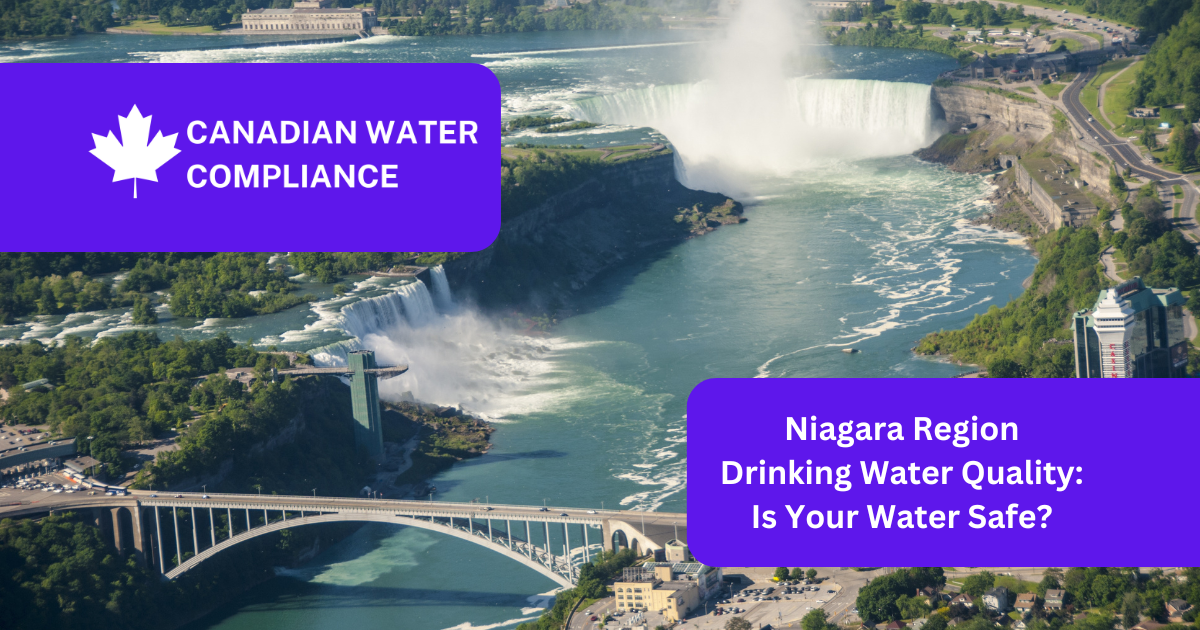
Written By: Canadian Water Compliance | On
The Niagara Region in Ontario is well-known for its stunning landscapes, thriving tourism, and rich history—but what about its drinking water quality? Ensuring access to safe and clean potable water is a priority for municipalities across the region. With multiple treatment facilities, strict testing protocols, and evolving environmental challenges, it's essential to understand how Niagara maintains its water safety standards.
In this guide, we’ll cover:
How Niagara’s drinking water is treated and monitored
Common water quality concerns in the region
Recent reports and compliance with Ontario regulations
How businesses and residents can ensure water safety
Water infrastructure improvements and future challenges
Niagara Region operates five municipal drinking water systems, ensuring safe potable water for over 447,000 residents. These systems are managed under Ontario's Drinking Water Quality Management Standard (DWQMS), which requires annual audits and strict compliance with water safety laws.
Source Water Protection – Water is drawn from Lake Ontario, the Niagara River, and Welland Canal.
Coagulation & Flocculation – Removes sediment and large particles.
Filtration – Eliminates smaller contaminants, bacteria, and debris.
Disinfection – Chlorine or UV treatment neutralizes harmful pathogens.
Testing & Monitoring – Continuous sampling ensures regulatory compliance.
Distribution & Storage – Treated water is stored in reservoirs and pumped to consumers.
DeCew Falls Water Treatment Plant (St. Catharines, Thorold)
Welland Water Treatment Plant (Welland, Pelham)
Grimsby Water Treatment Plant (Grimsby, Lincoln, West Lincoln)
Niagara Falls Water Treatment Plant (Niagara Falls, NOTL)
Rosehill Water Treatment Plant (Fort Erie, Port Colborne)
While Niagara's water supply meets Ontario’s Safe Drinking Water Act, 2002, certain risks persist:
Homes built before 1990 may have lead pipes or fixtures, potentially causing elevated lead levels in tap water.
Ontario’s Lead in Drinking Water Regulation (O. Reg. 243/07) mandates testing in schools, childcare centers, and high-risk properties.
The province has introduced corrosion control programs in older distribution systems to minimize lead leaching.
Niagara’s water systems undergo daily bacterial testing to prevent outbreaks.
Private well owners must conduct regular microbiological tests to ensure safety.
Public health authorities issue Boil Water Advisories (BWAs) if bacterial contamination is detected.
PFAS (“forever chemicals”) have been detected in some Canadian water sources and are being monitored in Niagara.
Microplastics in Lake Ontario have been flagged as a potential long-term health concern, though research is ongoing.
Ontario is considering stricter water quality guidelines for emerging contaminants in the coming years.
Certain areas, like Welland and Fort Erie, experience moderately hard water, leading to appliance scaling and plumbing buildup.
Water softeners can help reduce mineral deposits and improve water quality for residential and industrial use.
Hard water can impact boilers, cooling towers, and commercial plumbing systems, making regular testing essential.
Niagara Region is required to publish Annual Water Quality Reports, detailing compliance with Ontario’s drinking water laws. Some key highlights:
Niagara-on-the-Lake received perfect water quality grades in 2024, ensuring safe drinking water for residents (source).
St. Catharines’ water system met all provincial standards, with thousands of samples analyzed yearly to maintain compliance (source).
Niagara Falls and Welland continue to invest in water infrastructure improvements to enhance safety and reliability.
The Ontario Clean Water Agency (OCWA) is investing in new filtration technologies to combat evolving contaminants.
With a growing population and climate change affecting source water quality, Niagara faces challenges in maintaining its high standards. Key focus areas include:
Aging Infrastructure – Upgrading aging pipelines to prevent leaks and contamination.
Climate Change Resilience – Preparing for increased stormwater runoff and algal blooms in source water.
New Contaminant Monitoring – Researching and addressing pharmaceutical residues and industrial pollutants.
Public Awareness & Education – Encouraging businesses and residents to stay informed on water conservation and safety.
✅ Check for Lead Pipes – If your home or business was built before 1990, consider lead testing.
✅ Get Private Well Water Tested – If using a well, test for bacteria and nitrates at least twice a year.
✅ Monitor for Discoloration or Odor – Report any sudden changes in water quality to Niagara Region Public Health.
✅ Install a Water Filter If Needed – Reverse osmosis or activated carbon filters can help remove contaminants.
✅ Stay Informed with Annual Water Reports – Review your municipality’s latest water quality reports.
✅ Advocate for Infrastructure Upgrades – Support investments in local water treatment improvements.
Niagara Region maintains high water safety standards, but challenges like lead contamination, bacterial risks, and emerging pollutants mean ongoing vigilance is necessary. Regular water testing, proper maintenance, and staying informed are the best ways to ensure safe drinking water for businesses and households alike.
🔎 Need professional water testing in Niagara? Contact Canadian Water Compliance for certified testing services today!